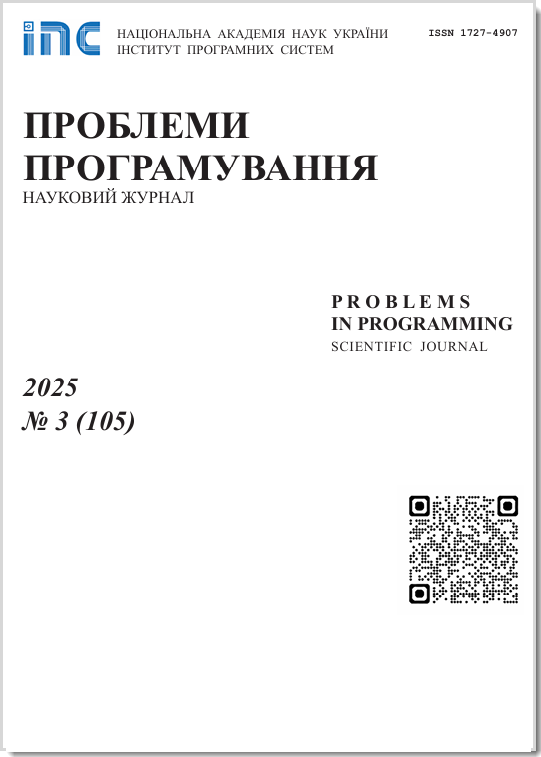Flow constructing and optimizing method for composite web service based on Q-learning
Abstract
We propose a method of automated flow generation for the web services composition according to the de fined target state based on reinforcement machine learning. An agent that uses Q-learning gradually accu mulates knowledge about the environment to updates the evaluations of the usefulness of its actions (these actions correspond to the existing services). The task is divided into two subtasks: - construction of possible flows represented as sequences of services where the results of the previous service execution change the current environment state and enable the exe cution of the next service; - choice of the optimal flow according to the history of interactions and to QoS criteria that is adapted to environment changes. We determine the main components of reinforcement learning and analyze their specifics for service com position task. Additional approaches that allow avoiding looping and the use of unnecessary services are considered. We propose modification of the Q-learning method developed for automatic generation of flows based on input and output data of web services and for selecting the optimal flow based on the analysis of their qualitative characteristics. This modified method uses approach with memory where the agent expands its knowledge about the environment at each step. We consider characteristics of proposed method based on analysis of its software implementation. Possibilities of proposed method are considered on example of generation an optimal study sequences used for individual educational trajectories in accordance with the personal needs of students. Every learning ob ject (information object used for educational needs described by metadata) is considered as a specific ser vice where inputs and outputs are represented by required and result competencies.
Problems in programming 2025; 1: 82-93
Keywords
Full Text:
PDF (Українська)References
Berners-Lee T., Web Services, Program Integration across Organization Application boundaries, and W3C, https://www.w3.org/DesignIssues/WebServices.html
Web Services Activity Statement, W3C, https://www.w3.org/2002/ws/Activity
Kashyap V., Bussler C., Moran M., Web Service Composition. The Semantic Web: Semantics for Data and Services on the Web. In: The Semantic Web. Data-Centric Systems and Applications. Springer, Berlin, Heidelberg. 2008, pp.233-248. CrossRef
Samuel A., Some studies in machine learning using the game of checkers. IBM Journal of research and development, 1959, 3(3), pp.210-229. CrossRef
Mitchell T., Machine learning. New York: McGraw-hill. 1997, Vol.1, No. 9 http://www.pachecoj.com/courses/csc380_fall21/lectures/mlintro.pdf.
Barto A., Sutton R., Reinforcement Learning: An Introduction, The MIT Press: Cam-bridge, Massauchsetts, 2018. https://web.stanford.edu/class/psych209/Readings/SuttonBartoIPRLBook2ndEd.pdf
Jang B., Kim M., Harerimana G., Kim J.W., Q-learning algorithms: A comprehen-sive classi-fication and applications. IEEE access, 2019. CrossRef
Lemos A.L., Daniel F., Benatallah B., Web service composition: a survey of techniques and tools. ACM Computing Surveys (CSUR), 2015, 48(3), 1-41. CrossRef
Uc-Cetina V., Moo-Mena F., HernandezUcan R., Composition of web services using Markov decision processes and dynamic programming. The Scientific World Journal, 2015 (1). CrossRef
Kalasapur S., Kumar M., Shirazi B.A.,Dynamic service composition in pervasive computing. IEEE Transactions on parallel and distributed systems, 2007, 18(7), pp.907-918. CrossRef
Gryshanova I., Rogushyna J., Technology of machine learning use for composite web service development. Problems in Programming, 2024, 4, pp.34-43. (in Ukrainian)
The OpenAPI Specification, https://swagger.io/specification/
Rogushina J., Gladun A., Anishchenko O., Pryima S., Semantic Support of Personal Learning Trajectory Development, in: UkrPROG 2024, CEUR Vol-3806, 2024, pp.487-505.
Politis D., Tsalighopoulos M., Kyriafinis G., Designing Blended Learning Strategies for Rich Content, Handbook of Research on Building, Growing, and Sustaining Quality E-Learning Programs, 2017.CrossRef
Rogushina J., Gladun A., Anishchenko O., Pryima S., Semantic analysis of learning objects: thesaurus approach for digital transformation of educational resources, CEUR Workshop Proceed-ings (2024), CEUR, Vol-3771, 85-99. ws.org/Vol-3771/paper13.pdf
DOI: https://doi.org/10.15407/pp2025.01.082
Refbacks
- There are currently no refbacks.









